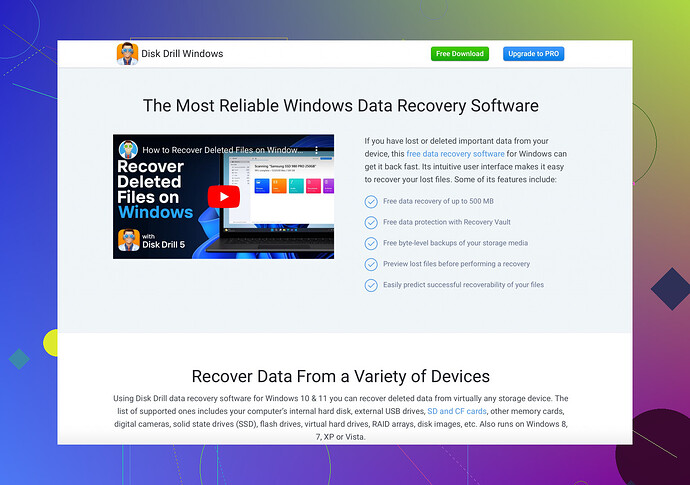I have a failing hard disk that contains crucial data. It’s making strange noises and taking forever to read/write files. What are the best repair tools or software I can use to fix it or at least recover my data? Any success stories would be helpful!
Yikes, sounds like your hard disk is on its last legs, giving you the classic signs of imminent failure. The annoying noises and sluggish performance are major red flags.
First up, for recovery, you should use software like Disk Drill Data Recovery Software. It’s pretty renowned for dealing with scenarios just like yours. It’s simple to use and supports a wide range of file systems, so it’s a good start.
-
Backup Immediately: Before doing anything else, if you can boot your computer at all, backup whatever you can. Even if it’s slow, just get your crucial files onto a different drive or cloud storage.
-
Disk Drill Data Recovery: This is hands-down one of the top tools out there. It can recover data from failing or even formatted drives. It’s got an intuitive interface and wide file system support, making it a reliable choice.
-
CHKDSK: You can use Windows’ built-in CHKDSK utility by typing ‘chkdsk /f /r’ in the command prompt. It might take some time, especially if the disk is on its way out, but it’s worth a shot.
-
SpinRite: This is a more technical tool but is quite effective on issues related to read/write errors. However, it’s kinda pricey and not exactly user-friendly.
-
Professional Services: If the data is super important and you can’t risk any DIY methods, sending in the drive to data recovery experts like DriveSavers or Seagate Recovery Services could be a lifesaver.
Remember, each time you run diagnostics or recovery, there’s a risk of pushing the drive closer to complete failure. So handle it with care. Good luck, and get those backups sorted ASAP!
Oof, sounds like you’re in quite the pickle. Here’s what I’d suggest, throwing in a bit of variety to what’s already been mentioned by @hoshikuzu.
-
Photorec: Have you tried using Photorec? It’s an open-source tool that’s excellent for recovering data from dying drives. It doesn’t repair, but it’s a great recovery tool that operates on both Windows and Linux.
-
Recuva: Another nifty tool is Recuva, especially for those who aren’t too tech-savvy. It’s rather straightforward and can recover lost files efficiently. It’s a bit lighter than Disk Drill but quite effective for simpler recoveries.
-
G-Parted Live: If you’re a bit more tech-savvy and comfortable with live boot environments, give GParted Live a shot. It’s primarily a partition tool but can sometimes help recover data by recreating the file structure.
But let’s not kid ourselves; if your disk is making strange noises, software alone might not cut it. Physical damage could be the issue, and that’s a bit above what most software can handle. Running too many diagnostics and repair attempts might do more harm than good in this state.
Personally, I’d consider investing in a new drive if this data is crucial. Clone your failing drive as best you can and then try recovery on the clone. Tools like Disk Drill are SEO-friendly recovery solutions that can help after you’ve done the basic backup.
Lastly, while DIY methods are great, don’t gamble with critical data. If your attempts fail, professional data recovery services might be the only solid bet.
Remember, the clock is ticking, and you don’t want that drive failing completely while you’re trying to fix it.
Alright, let’s talk data recovery! Your drive making noises and dragging its heels is a big red flag. Here’s a step-by-step guide that’ll complement what @sterrenkijker and @hoshikuzu mentioned without parroting them.
-
Prioritize Backup: First, connect your failing drive to another system if you can. Use external casings or SATA-to-USB adapters for internal drives. Copy all essential files manually before the drive goes kaput.
-
Disk Cloning Tools: Clonezilla could be a savior here. It’s free and can clone failing drives, allowing you to work on a copy without risking your original.
-
Try Disk Drill: This tool has a user-friendly interface, making it easy for non-techies to recover lost data. Disk Drill supports multiple file systems (FAT, NTFS, HFS+, etc.) and can recover partitions. However, the free version has limited capabilities and the recovery process might be slower than other pro tools.
-
HDD Regenerator: This tool specifically targets bad sectors and can repair them. It’s effective, but keep in mind it’s more of a shot in the dark. Physical damage won’t be fixed by any software.
-
Professional Data Recovery: Really stressed about that irreplaceable data? Send it to the pros like DriveSavers. It’s expensive but worth it for critical data. Remember, attempts to repair the disk might worsen the situation, so tread carefully.
Pros of Disk Drill:
- Easy to use with intuitive UI
- Supports a breadth of file systems
- Effective for partition recovery
Cons of Disk Drill:
- Limited functionality in free version
- Slower recovery speeds compared to specialized tools
While @sterrenkijker suggested Photorec for a more tech-savvy crowd and @hoshikuzu recommended Recuva for its simplicity, Disk Drill offers a balance of ease and functionality. If cloning and software attempts fail, dish out for the experts. Your drive’s time might be ticking, so act fast!
